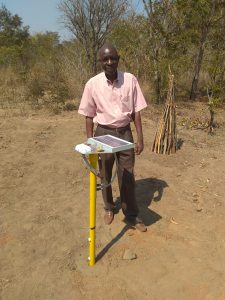
- Built-in solar panel
- Iridium SBD satellite communications
- Air temperature and relative humidity at three heights (ground level, 20cm and 1m)
- Light intensity
- Soil temperature and soil moisture probes
- Guide price £1450+VAT
We have developed and deployed a set of solar-powered climate monitor for use in remote locations where GSM or other communications are unavailable or unreliable. The initial deployment was in Zambia as part of a research project. It is completely standalone and uses the Iridium satellite service to relay data. The monitor is still under development, and has a number of additional hardware features that we are working on fully exploiting.
Please contact info@ystumtec.co.uk for more information or to buy.
Overview:
The monitor measures air temperature and relative humidity at three heights: ground-level, 20cm and 100cm. It also measures soil temperature, soil moisture (VWC) and light-level. Measurements are made once per minute and data is stored internally on a uSD card. The current version is equipped with an Iridium Edge satellite modem which relays data at hourly intervals. Data relayed includes maxima, minima and mean values for temperatures, and light level, and mean values for soil moisture, relative humidities and battery status. The solar panel is sized such that it is expected to supply power for the system indefinitely at locations below 60 degrees latitude if positioned in an unobstructed location. It would be relatively easy to switch the Iridium modem for a GSM modem, so if you are put off by the relatively high cost of satellite communication then please ask. Communication via the Iridium network costs around $1 per day (2018 rates) for hourly transmissions. The monitor is also equipped with a low-power radio transceiver which is not being used in the current deployment, but which allows data from other sensors to be received, stored and relayed. Please ask if this type of system or an adaptation of it could be of interest to you.
Physical considerations:
The monitor electronics are built into a 50mm fibreglass tube with an aluminium top-plate upon which the solar panel and satellite modem are mounted. The antenna for the low power radio and the uSD mount are on the PCB inside the tube. The uSD card is accessed via a removable panel on the side of the tube. The tube is 1500mm long in total, and a hole 500mm deep must be made to drop the tube in to. The soil moisture sensor is deployed on a short cable that is pulled out of a slot in the buried part of the tube. Typically the soil moisture sensor is buried at a depth of around 50mm. The sensor tube and top-plate assemblies are very robust, but the tube must not be banged, dropped or hammered in to the ground: dig a hole to the correct depth and then place the tube in the hole, pull the soil moisture sensor out of the slot in the bottom part of the tube and back-fill with soil ensuring that the sensor is placed at the required depth.